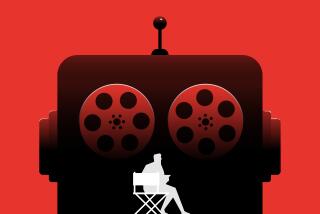Pixar’s John Lasseter, Buzzfeed’s Ze Frank embrace filmmaking in digital world
Pixar co-founder John Lasseter believes “if you use technology correctly, you can change opinions overnight.”
And the animation legend can prove it. Twenty years ago, the idea of creating a full-length computer animated film was unheard of. But “Toy Story,” the popular animated franchise Lasseter is known for, became an instant hit among moviegoers.
“What’s great about film is it constantly reinvents itself. People didn’t understand what technology could do,” Lasseter said at an Academy of Motion Picture Arts and Sciences event on Tuesday. “It’s important to make the technology invisible but have it really push to do something new so people look at it and go ‘wow, what’s that, that’s amazing.’”
Soon, Lasseter, who is the chief creative officer of Walt Disney Animation Studios and Pixar Animation Studios, predicts filmmakers will solely use their iPhones and GoPros to create award-winning full-length films.
“People will tell you, ‘That’s not going to work,’ but yeah, that’s going to work,” he said. “But the reason they say that is because it’s not what they are used to.”
The event, titled “The New Audience: Moviegoing in a Connected World,” also featured presentations from Buzzfeed Motion Pictures President Ze Frank, 22-year-old filmmaker Tayo Amos and USC professor Henry Jenkins.
The speakers then discussed the evolution of media consumption and moviegoing in a panel, moderated by Vanity Fair’s West Coast Editor Krista Smith.
“It’s not the technology that entertains people, it’s what you do with the technology,” Lasseter added. “If you create characters people connect with and tell stories that deeply entertain and move them… the audience will come.”
Frank backed that point during his presentation by showing a short Buzzfeed Motion Pictures video called “Weird Things All Couples Fight About.” The roughly three-minute clip follows a male and female couple as they fight over little things such as what to order for dinner. It has been viewed 3.7 million times on YouTube to date.
The key in figuring out why some videos are more shared than others, Frank said, is to measure the audience and see what they respond to and how they respond.
“There’s a whole class of people’s experiences in the world that have been underserved in the media,” Frank said.
Though digital content is often pointed to as a threat to cinema, Frank said he thinks “it has an amazing opportunity to reinvigorate it.”
Amos, a recent Stanford University graduate, echoed the importance of technology in filmmaking.
“This is the brave new world of storytelling,” the young filmmaker said. “We may not be able to predict the future, but we can always embrace it.”
For more news on the entertainment industry, follow me @saba_h
More to Read
From the Oscars to the Emmys.
Get the Envelope newsletter for exclusive awards season coverage, behind-the-scenes stories from the Envelope podcast and columnist Glenn Whipp’s must-read analysis.
You may occasionally receive promotional content from the Los Angeles Times.







